Pig and Pepper
Studies in Alice VI, by Marc Edmund Jones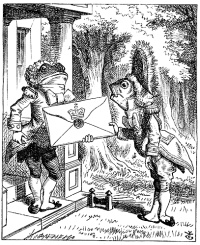 This lesson considers the sixth chapter of
Alice in Wonderland and the sixth great
principle of wisdom in the Philosophy of
Concepts as revealed through the
adventures of Alice is that growth lies in
pain. In many departments of life this fact
is well recognized, particularly in
parturition and in the detail of
psychological development of the
individual, but the world is still far from
acceptance of the universal nature of the
principle and indeed almost the first effort
of every man today is directed toward
escape from pain. When understood, so
that the mind and the poignancy of
sensation are in sympathetic unity, pain
becomes pleasure and to it under many
circumstances the term ecstasy is given.
Even extreme pain may be sought with joy
as in the case of the youth who coined the
phrase it hurts so good as excuse for
deliberate irritation of injury. Thus it is
that many people cling to both physical and psychological injuries when conditions have brought
about adequate lack of self-expression with the resultant perversion in point of view. In an
understanding of the law of pain is found the only explanation of the martyr temperament that in
this philosophy and from any spiritual consideration is regarded as perhaps the most inexcusable
of human weaknesses. The universal law of pain is that every individual must either give or
accept pain as the active basis of his experience in consciousness. As growth is necessary in all
things, so pain is necessary as the fundamental element of that growth. It is the creative element
in the consciousness.
This lesson considers the sixth chapter of
Alice in Wonderland and the sixth great
principle of wisdom in the Philosophy of
Concepts as revealed through the
adventures of Alice is that growth lies in
pain. In many departments of life this fact
is well recognized, particularly in
parturition and in the detail of
psychological development of the
individual, but the world is still far from
acceptance of the universal nature of the
principle and indeed almost the first effort
of every man today is directed toward
escape from pain. When understood, so
that the mind and the poignancy of
sensation are in sympathetic unity, pain
becomes pleasure and to it under many
circumstances the term ecstasy is given.
Even extreme pain may be sought with joy
as in the case of the youth who coined the
phrase it hurts so good as excuse for
deliberate irritation of injury. Thus it is
that many people cling to both physical and psychological injuries when conditions have brought
about adequate lack of self-expression with the resultant perversion in point of view. In an
understanding of the law of pain is found the only explanation of the martyr temperament that in
this philosophy and from any spiritual consideration is regarded as perhaps the most inexcusable
of human weaknesses. The universal law of pain is that every individual must either give or
accept pain as the active basis of his experience in consciousness. As growth is necessary in all
things, so pain is necessary as the fundamental element of that growth. It is the creative element
in the consciousness.
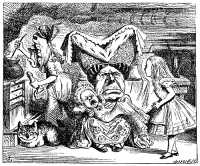 Here is the principle of
stimulation. Man may
expand and accept the
growth necessary to his
continuance in the individual
existence and well-being in
either the outward and
objective or inward and
subjective or subconscious
realms as he pleases, but as
he may elect to focus his
activity of awareness in one
he sets up a complementary
stimulative manifestation of
the other and this is known
to him either as pain or as
the joy that is the
pleasurable phase of the
same phenomenon. To the
person seeking expansion in the outer world of every day as he invites subjective stimulation,
both pain and pleasure will serve to enhance appreciation or dislike of objective things and
relations and the sources of this pain or pleasure will appear to be beyond conscious control and
tend to force this individual into more intense living within the moment. Conversely the person
seeking expansion in the realm of higher things invites stimulation at the hands of outer and
practical life. He encounters a lack of understanding that drives him into appreciation of
subjective principles. His sources of pain and pleasure are objective and so invite control, and
he is forced into more intense living in the future and in the past as psychologically the same
thing. In either case the man who seeks to avoid pain because the element is an integral part of
his consciousness proceeds willingly or unwillingly to give pain to others. In this giving of
poignancy to others the practical individual is mentally cruel. Hence the biting criticism of
those who approach spiritual studies selfishly or for the obtaining of worldly goods, and the
mystical individual is physically cruel as shown by the odd and terrible crimes committed by
those unbalanced by religious mania. In the
Philosophy of Concepts development is offered to
individuals of either type and the method, which is
simple enough when properly understood, is to teach
the student to accept gratefully the pain that comes to
him until such time as he learns not to give pain that is
resented by others and therefore destructive but rather
the intensified poignancy known as ecstasy or
constructive joy. By an alternating emphasis of realms
an aspirant may gain a rounded development that is
neither slavery to things nor yet a meaningless and
empty mysticism.
Here is the principle of
stimulation. Man may
expand and accept the
growth necessary to his
continuance in the individual
existence and well-being in
either the outward and
objective or inward and
subjective or subconscious
realms as he pleases, but as
he may elect to focus his
activity of awareness in one
he sets up a complementary
stimulative manifestation of
the other and this is known
to him either as pain or as
the joy that is the
pleasurable phase of the
same phenomenon. To the
person seeking expansion in the outer world of every day as he invites subjective stimulation,
both pain and pleasure will serve to enhance appreciation or dislike of objective things and
relations and the sources of this pain or pleasure will appear to be beyond conscious control and
tend to force this individual into more intense living within the moment. Conversely the person
seeking expansion in the realm of higher things invites stimulation at the hands of outer and
practical life. He encounters a lack of understanding that drives him into appreciation of
subjective principles. His sources of pain and pleasure are objective and so invite control, and
he is forced into more intense living in the future and in the past as psychologically the same
thing. In either case the man who seeks to avoid pain because the element is an integral part of
his consciousness proceeds willingly or unwillingly to give pain to others. In this giving of
poignancy to others the practical individual is mentally cruel. Hence the biting criticism of
those who approach spiritual studies selfishly or for the obtaining of worldly goods, and the
mystical individual is physically cruel as shown by the odd and terrible crimes committed by
those unbalanced by religious mania. In the
Philosophy of Concepts development is offered to
individuals of either type and the method, which is
simple enough when properly understood, is to teach
the student to accept gratefully the pain that comes to
him until such time as he learns not to give pain that is
resented by others and therefore destructive but rather
the intensified poignancy known as ecstasy or
constructive joy. By an alternating emphasis of realms
an aspirant may gain a rounded development that is
neither slavery to things nor yet a meaningless and
empty mysticism.
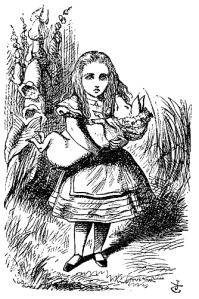 The symbolism of the sixth chapter in Alice is vital at
this point in bringing out in striking fashion the
universal principles of this law of pain. The pepper is
the negative and the thrown dishes are the positive
irritating pain-giving elements. The sneezing as the
recognition of irritation is the convulsive action of the
body that loosens the vehicles of higher consciousness
and for the moment separates them from the physical
body and so intensifies sensation. Because of this projection of self out of the physical
embodiment during the instant of sneezing all primitive people hastened to bless a sneezer.
When the baby was not stirred up enough or the confusion as exaggerated symbol of awareness
was not great enough, the dishes were thrown to supplant the pepper in its work. When an
individual cannot find enough pepper or pep in life to sneeze at, life promptly bombards him
with dishes or his accustomed utensils of being.
The symbolism of the sixth chapter in Alice is vital at
this point in bringing out in striking fashion the
universal principles of this law of pain. The pepper is
the negative and the thrown dishes are the positive
irritating pain-giving elements. The sneezing as the
recognition of irritation is the convulsive action of the
body that loosens the vehicles of higher consciousness
and for the moment separates them from the physical
body and so intensifies sensation. Because of this projection of self out of the physical
embodiment during the instant of sneezing all primitive people hastened to bless a sneezer.
When the baby was not stirred up enough or the confusion as exaggerated symbol of awareness
was not great enough, the dishes were thrown to supplant the pepper in its work. When an
individual cannot find enough pepper or pep in life to sneeze at, life promptly bombards him
with dishes or his accustomed utensils of being.
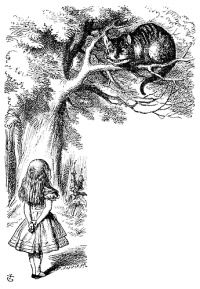 The achievement of imagination in the
chapter, or the sixth great scientific
anticipation, is the revelation of the
indestructibility of form that is taught
through scientific channels as the intelligence of nature. Life precedes
embodiment in the sense that the
potentiality actually constitutes the life
apart from the force and the substance
involved, these being elements easily
traceable to purely chemical factors
when the concepts of material science
are used. Therefore the tree or plant is
foreshadowed in the seed and the nature
and character of the young animal from
its parents. The growth of new and
variant forms is no exception to the rule
because they may be traced to a
blending of factors or to the activity in
imagination of the existing forms. In
either case the life or the idea precedes
the outer manifestation and this in turn
is not new form but is an adaptation of
those forms that exist and are
indestructible.
The achievement of imagination in the
chapter, or the sixth great scientific
anticipation, is the revelation of the
indestructibility of form that is taught
through scientific channels as the intelligence of nature. Life precedes
embodiment in the sense that the
potentiality actually constitutes the life
apart from the force and the substance
involved, these being elements easily
traceable to purely chemical factors
when the concepts of material science
are used. Therefore the tree or plant is
foreshadowed in the seed and the nature
and character of the young animal from
its parents. The growth of new and
variant forms is no exception to the rule
because they may be traced to a
blending of factors or to the activity in
imagination of the existing forms. In
either case the life or the idea precedes
the outer manifestation and this in turn
is not new form but is an adaptation of
those forms that exist and are
indestructible.
Thus in the remarkable creation of Lewis Carroll's Cheshire cat it is first of all the grin. When fully embodied it was this smile that distinguished the feline lady and the grin here represents consciousness as preceding its outer manifestation. It is curious that in astrology Leo or the cat has to do with materialization and dematerialization and also that this animal was held the most sacred in Egypt.
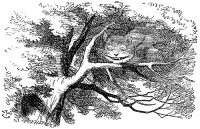 The law of applied psychology
or the sixth big idea for the
solution of personal problems is
brought out here in the technique
of humanizing. Human
constitution is fundamentally a
matter of four-fold being. Cat
and grin are the mental nature.
The duchess or the embodiment
of human social and political
recognition is the emotional, the
cook is the habit and the baby is
the physical. Through these the
phenomenon of the developing
consciousness is possible.
During growth the real-self grins and bears and remains detached and will only materialize in
moments of real interest. The emotions scold and shake to give the necessary pain if the being
will accept it whereas the habit nature throws things and seeks to hurt or awaken consciousness.
The physical or outer real self screams and sneezes or makes itself manifest and is only turned
into a pig or made gross through mistaken kindness by means of which too many seeking souls
are deprived of their experience. The student must learn to MAKE A GAME OF IT whenever
life presents a seemingly unconquerable difficulty. Alice learns to tie the baby in knots and
aspirants must learn to make life complicated and fit things into seemingly the complex ritual of
larger patterns.
The law of applied psychology
or the sixth big idea for the
solution of personal problems is
brought out here in the technique
of humanizing. Human
constitution is fundamentally a
matter of four-fold being. Cat
and grin are the mental nature.
The duchess or the embodiment
of human social and political
recognition is the emotional, the
cook is the habit and the baby is
the physical. Through these the
phenomenon of the developing
consciousness is possible.
During growth the real-self grins and bears and remains detached and will only materialize in
moments of real interest. The emotions scold and shake to give the necessary pain if the being
will accept it whereas the habit nature throws things and seeks to hurt or awaken consciousness.
The physical or outer real self screams and sneezes or makes itself manifest and is only turned
into a pig or made gross through mistaken kindness by means of which too many seeking souls
are deprived of their experience. The student must learn to MAKE A GAME OF IT whenever
life presents a seemingly unconquerable difficulty. Alice learns to tie the baby in knots and
aspirants must learn to make life complicated and fit things into seemingly the complex ritual of
larger patterns.

Sabian.org





